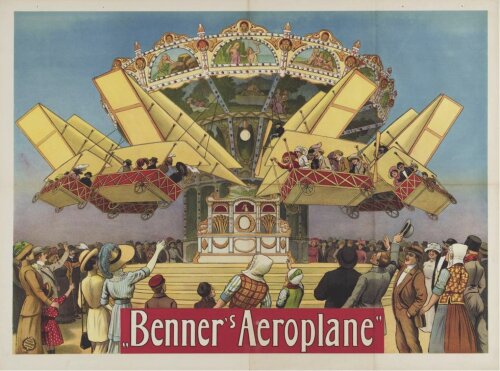SciFair is conducting pioneering research on the role itinerant showpeople played in the transmission and popularization of science, technology and visual culture at North-Western European fairgrounds between 1850 and 1914. At a time when modern communication media were not yet in place and only a minority of the population could read, large groups of people were actually dependent on travelling performances and displays for information: in so-called anatomical cabinets, zoological and anthropological museums and scientific theatres, showpeople demonstrated ‘wonders of nature’ and spectacular scientific developments.

Benner's Aeroplane, 1913. Poster by Adolph Friedländer, Theater collection UvA (Allard Pierson)
The project advances the hypothesis that the fair in this period was not merely a local folk tradition, but a hub for international exchange in which itinerant entertainment played a pivotal and modernising role in the circulation and popularisation of science amongst people across the social spectrum, relying on efficient international networks. In order to test this hypothesis, the project will bring together a multilingual and multidisciplinary team of researchers that will combine methodologies from theatre and performance studies with perspectives from history of science, media studies and digital humanities to analyse practices of science performance across national boundaries and map transnational networks of North-Western European fairground theatres. SciFair will not only study explicit didactic discourses but also analyse how implicit knowledge and social values of health, gender, nation, class or race were challenged or reinforced.
By analysing the fair as a performative event, the project will contribute to our understanding of the social and cultural role of the fair in the circulation of knowledge, media and visual culture.
Scope
The project will focus on Belgium, and its neighbouring countries France, The Netherlands, Germany and Luxembourg over several decades and generations, allowing for a synchronic and diachronic analysis. These countries were at the forefront of the continent's industrialization and include the most common and feasible itineraries within the scope of certain language areas.
The period to be studied begins around 1850 – when industrial modernity marked a shift from rural and religious fairground traditions to prevailingly entertainment fairground culture – and ends in 1914 with the disruption caused by the First World War.
The project will employ the term ‘science’ for abroad range of disciplines, including (visual) knowledge on anatomy, medicine, geography, history and technology.